|
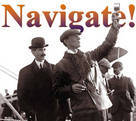
 Up
Up 
 Wright
Wright
airplanes 
(You are here.)
 Down
Down




  Need
to Need
to
find your
bearings?
Try
these
navigation aids:
If
this is your first
visit, please stop by:
Something
to share?
Please:



|
|
Available in Française, Español, Português, Deutsch, Россию,
中文,
日本, and others.
|
|
1903 Flyer I
– The Wright brothers first powered aircraft, and the first in which anyone made a
sustained, controlled flight. As in their earlier gliders, it had a
variable-camber twin canard in front to control pitch and a twin rudder in
back to control yaw. Roll was controlled by warping the wings.
|
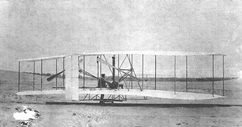
Orville checks the Flyer I as it rests on the launching rail on the
sands near Kitty Hawk, NC..
|
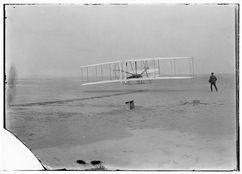
The first flight of December 17, 1903.
|
1904 Flyer
II
– The Wright brothers second powered aircraft was almost a
complete copy of the Flyer 1, but it had a flatter camber and
stronger skids. It was not a capable flyer; the Wrights learned
they learned they still had a lot of work to do before they had a practical
airplane. Nonetheless, this was the first airplane to fly a complete circle,
returning to the point where it took off. It was also the first aircraft on which the Wrights used their
distinctive "bent-end" propellers.
|
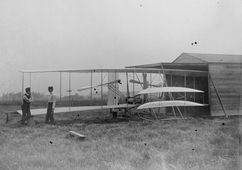
Wilbur and Orville in discussion with the Flyer II and its hangar in
the background.
|
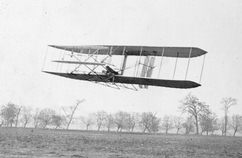
The Flyer II flying over Huffman Prairie on November 16, 1904.
|
1905 Flyer
III
– The Wright's 1905 aircraft, their third powered machine, was the world's first practical
aircraft. Both the canard and the rudder were extended out from the
aircraft to make it easier to control. Semi-circular "blinkers"
between the surfaces of the canard prevent the nose from dropping in a
turn. With this aircraft, the Wrights were able to fly until their fuel
ran dry. In 1908, they adapted the Flyer to carry the first airplane
passenger.
|
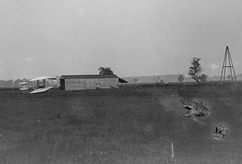
The Flyer III being launched by catapult (the tall tower to the
right) in June of 1905.
|
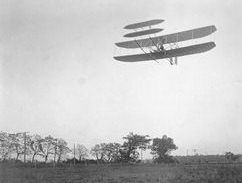
The Flyer III during one of its public flights on October 4, 1905.
|
1907-1909 Wright Model A
– This was the aircraft that convinced the world that the Wrights had indeed flown.
It was also the first two-seat aircraft, and the first Wright aircraft in
which the occupants sat upright. Like all previous aircraft, the Wright
built it in Dayton, Ohio; then shipped it to France in 1907. When
they had hammered out a deal with some French industrialists, Wilbur
put it together in 1908 and began to fly. Back in America, he
demonstrated the Model A before millions of people in New York City,
circling the Statue of Liberty..
|
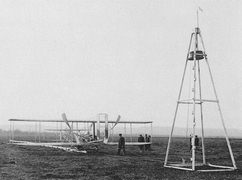
A Model A on the launching rail with the catapult cocked in the
spring of 1909.
|
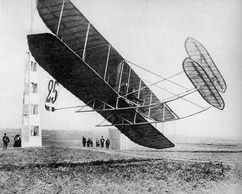
A Model A rounds a pylon at the air races in Rheims, France in 1909.
|
1909 Military Flyer
– Slightly smaller than the Model A, the Wrights sold this aircraft to the
United States Army Signal Corp to become the first military aircraft. This
was also the first aircraft the Wrights designed for speed – they
did so because their contract with the US Department of War
specified a minimum speed of 40 mph (64 kph) and granted them a
bonus of $2500 for every 1 mph (1.6 kph) over the minimum. The
Military Flyer turned in a top speed of 42 mph (68 kph). Once the US
military purchased the aircraft, it was used to train the
first military pilots.
|
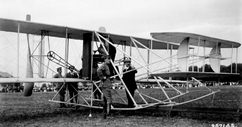
Orville discusses the next flight with Lt. Frank Lahm in front of
the Military Flyer.
|
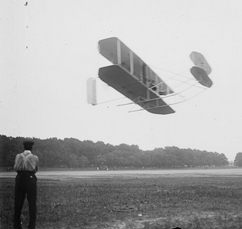
Wilbur watches Orville demonstrate the Military Flyer at Fort Myer,
VA in 1909.
|
1909-1910 Wright
"Transitional" Model A – Sometimes called the Model
A-B, this was the first airplane that the Wrights built with an elevator
in the back. However, they retained the canard in front, using both
surfaces to control the pitch of the aircraft. It was used to train the
first civilian pilots and was the one and only aircraft in which
Wilbur and Orville Wright flew in together. They also gave their
father Milton his only airplane ride in this machine.
|
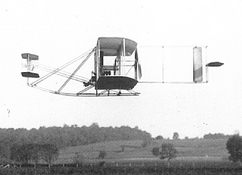
The Wrights test an aircraft with an elevator in the front and the
back.
|
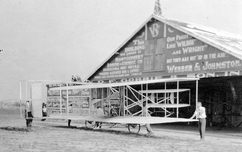
The Wrights trained their exhibition students to fly on a Model AB
at their flight school in Montgomery, AL.
|
1910-1914 Model B
– Built by the newly formed Wright Company, this was the first
mass-produced airplane. It was also the first Wright airplane
without a canard. It had a single elevator in the back, just behind an
enlarged twin rudder. Triangular blinkers were mounted on the forward skid
struts. The airplane rested on wheels, dispensing with the need to launch
the aircraft from a rail. Like all previous Wright aircraft, it used wing
warping to control roll.
|
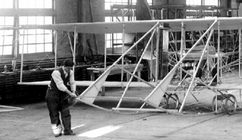
A Wright Model B rolling off the assembly line at the Wright Factory
in Dayton, OH.
|
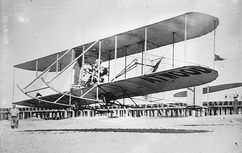
Charles Atwood takes off from a beach in his Model B.
|
1910 Wright Model R
–
Also called the "Roadster" and the "Baby Wright," this
small single-seat aircraft was built for racing. It had either a 4- or 8-cylinder
motor and could achieve speeds of 70 to 80 miles per hour. The Wrights
achieved these speeds not just by adding power, but also by reducing
drag. The wings were short (reducing wing surface) and the wings
were set closer together (reducing the length of the rigging wires.)
|
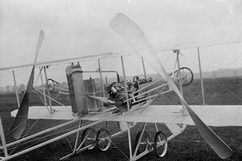
A close-up of the V-8 engine that powered the Model R.
|
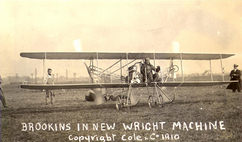
The Model R ready to launch.
|
1911-1912 Wright Model EX
– Built especially for exhibition flight, this aircraft had a
shorter wing span than other models, which gave the exhibition pilots more
speed. It also had a single seat, which prevented them from taking
passengers. This was a follow-on to the Model R, using some of the
same design technique to reduce drag. But it had longer
wings and a standard Wright 4-cylinder motor. This was
the first aircraft to be flown across a continent, crossing America is a
series of harrowing flights that took 82 days to complete as the
pilot, Cal Rodgers, met with one mishap after another.
|
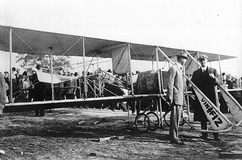
The Wright Model EX "Vin Fiz" just before it began it's
transcontinental flight from Sheepshead Bay, NY to Long Beach, CA.
|
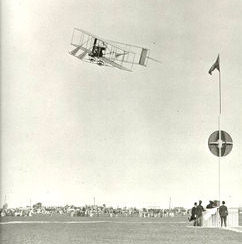
A Wright Model EX turning round a pylon at an exhibition flight in
Mineola, NY.
|
|
1912-1913 Wright Model C
– This aircraft replaced the Model B as the standard Wright Aircraft. It
had slightly flatter wings and a taller rudder for improved directional
control. The blinkers became rectangular vanes attached to the front end
of the skids. It was the first aircraft to use a Wright 6-cylinder motor,
an elongated version of their standard 4-cylinder engine. They extra
power and speed made the aircraft more difficult to fly. After a
series of accidents, the US military decide to ground all "pusher"
aircraft, including all Wright models. |
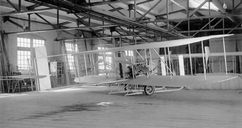
A Wright Model C on the factory floor. Note that the rudder now
rises above the top outriggers that hold the tail.
|
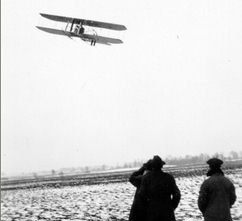
Orville flew a Model C to demonstrate his "automatic stabilizer,"
the first autopilot.
|
1912 Wright Model D
–
This was a light, fast single-seat aircraft that the Wright built in
response to the U.S. Army's request for a "speed scout." By
marrying their new powerful
6-cylinder engine with a short-wing airframe (similar to the Model EX),
the Wrights achieved a top speed of 66
miles per hour. But the aircraft was difficult to fly. With the US
military beginning to back away from the pusher configuration, it
had no market. Only one was built.
|
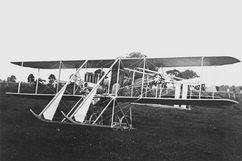
The Wright Model D on the ground at Simms Station (Huffman Prairie).
|
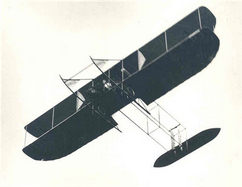
The Wright Model D during a demonstration flight.
|
1913 Wright Model CH
– Although the Wrights and others had mounted floats on their Model
B aircraft, this was the first dedicated Wright hydroplane. It was
essentially a Model C on a single wide
pontoon. Later versions had two slender "stepped" pontoons. The tail was supported by a smaller
float mounted under the
rudder.
It was a heavy lifter for a water-based aircraft, able to lift over
800 lbs (363 kg) off the surface. |
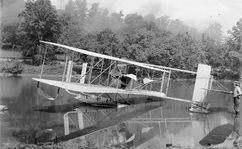
An early Model CH at anchor on the Great Miami River.
|
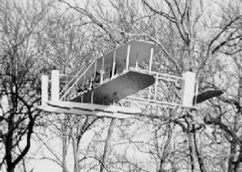
A later Model CH with stepped pontoons. The steps helped the
aircraft "break the surface" of the water.
|
1913 Wright Model E
–
A one-seat exhibition machine, this was the first Wright aircraft with a
single propeller. The tail booms were attached further out on the wings to
make room for the 7-foot chain-driven propeller. It's simple design made
it easy to set up and tear down, make it easy to transport. This was
also the machine that Orville chose to demonstrate his automatic
stabilizer for the first time.
|
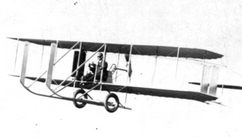
The Wright Model E was intended as an exhibition aircraft – it could
be set up and ready to fly in under an hour.
|
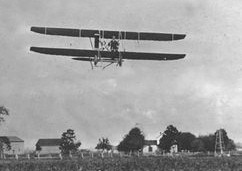
A Model E over Simms Station.
|
1913 Wright Model F
– The Model F marked a radical departure in design for the Wright
Company. They dispensed with blinkers and curtains and added a
fuselage. They moved the motor forward of the wings, created a
semi-standard tail by resting the rudders atop the elevator, and
hinged the elevator. (Earlier Wright elevators had simply flexed.)
The fuselage was partially covered in aluminum, earning it the
nickname, "Tin Cow."
|
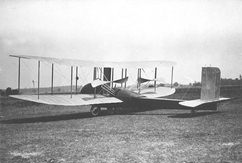
A drive shaft ran from the engine in the nose between the seats to
the chain drive.
|
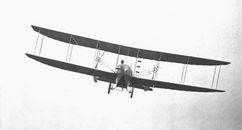
The Model F had a pronounced wing dihedral to increase lateral
stability.
|
1913-1914 Wright Model G
– This was the only flying boat built by the Wright Company. It was
designed by Grover Loening, first under the supervision of Wilbur Wright,
then after Wilbur's death, under Orville's supervision. It was the
last airplane project in which both the Wright brothers contributed
to the design. As such, it was the end of the collaboration of
genius that had begun the aviation industry.
|
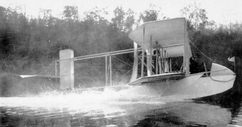
An experimental version of the Model G makes a take-off run from the
Great Miami River near Dayton, OH.
|
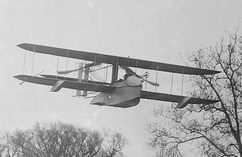
The Wright Model G on approach for a landing.
|
1914-1915 Wright Models H & HS
– These two aircraft were very similar to the Model F, but the
fuselage was streamlined so that it tapered back to the tail. The HS
had a short wingspan, just 32 feet (9.75 meters) to give it more
speed and increased rate of climb. The H had longer wings for an
increased payload. This was the last Wright "pusher" and the
last with a double rudder.
|
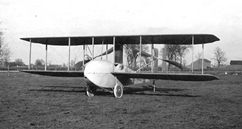
The Wright Model HS at Simms Station. Note the wheel spokes have
been covered with plates. This decreased drag.
|
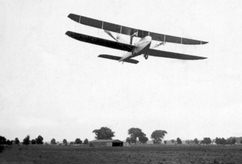
With its long wings, the Model H could carry over 1000 lbs (454 kg).
|
|
1915
Wright Model K – This was a seaplane, manufactured for the United States Navy. The
Model K was Wright Company's first tractor airplane with the propellers
facing forward. It was also the first Wright aircraft to use ailerons. And
it was the last to use the distinctive Wright "bent-end" propellers,
designed nearly ten years previously. |
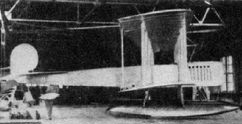
The Model K rest on its pontoons in the Wright factory.
|

The Model K taxies in the ocean water prior to take-off.
|
1916 Wright
Model L – The Model L was a single place airplane, designed to
fill the U.S. Army's request for a light, fast scouting machine.
This was the last aircraft manufactured by the Wright Company. Orville had
sold the company by this time, but he may have had some small influence on
the design since he was retained as a consultant for a short time after
the sale.
|
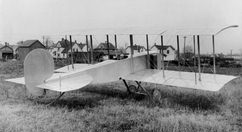
The Wright Model L used the same standard control surfaces as the
Model K.
|
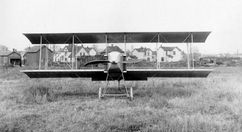
The Model L did away with the chain drive. There was a single
propeller mounted directly to the engine.
|
1918
Liberty Eagle – Orville Wright and Fred
Nash designed this tiny unmanned biplane while working for the
Dayton Wright Airplane Company, a manufacturing concern formed to
produce airplanes for World War I. The Liberty Eagle –
nicknamed the Bug – carried 200 lbs (91 kg) of explosives
and was guided by a gyroscopic stabilizer. It was the first attempt
at a guided missile. When tested in Pensacola, FL, the Eagles
performed well enough that over half did some damage to their
target.
|
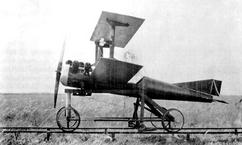
A Liberty Eagle rests on
launching trolley. The 4-wheeled trolley rolled along a straight
stretch of track on take-off, allowing the biplane to build up
flying speed – not too different from the way the 1903-1905 Flyers
were launched.
|
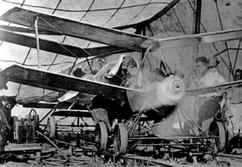
Testing the 37-hp engine of the
Liberty Eagle.
|
1919
OW.1 Aerial Coupe –This four-place
cabin biplane was designed by Orville Wright for the Dayton Wright
Airplane Company when World War I ended and the company attempted to
switch from military to commercial aviation. The Aerial Coupe
was luxury transportation with a roomy, well-appointed cabin. It
also performed well, setting an altitude record in 1920. But it
never found its market; only one was built. It was the last airplane
designed by one of the Wright brothers.
|
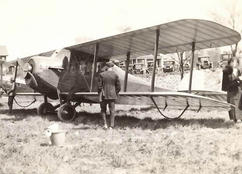
The OW.1 Aerial Coupe on
display next to another Dayton Wright airplane -- a peace-time
version of the DH-4.
|
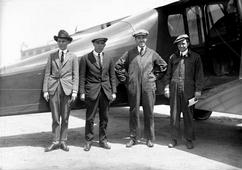
Dayton-Wright pilot Bernard Whelan (third from the left) and three
passengers about to set an altitude record in the
OW.1 Aerial Coupe.
|
Note: The Wright Company never made a
Model I or a Model J. These were made by the Burgess Company which
licensed Wright patents. In a letter to the Secretary of War dated 22
January 1914, Orville Wright claimed that the Burgess models
infringed on these patents. Burgess was licensed to build only exact
copies of Wright aircraft and the Burgess Models I and J, while
based on Wright designs, incorporated other features.
|
|
|